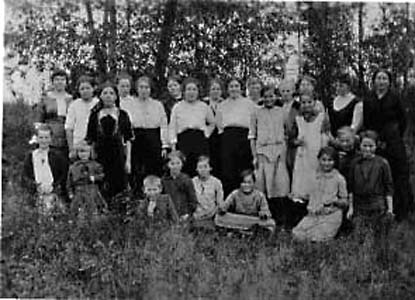Search | Image Archive | Reference | Communities | POV | Lesson Plans | Credits
 In the first decade of the twentieth century, Manitoba's population grew by nearly one half, largely through immigration. Many of the new immigrants became homesteaders, but few of them arrived equipped with the knowledge and experience to successfully farm the prairies.
In the first decade of the twentieth century, Manitoba's population grew by nearly one half, largely through immigration. Many of the new immigrants became homesteaders, but few of them arrived equipped with the knowledge and experience to successfully farm the prairies.
Recognizing the need to develop agricultural education programs, the Provincial Department of Agriculture established the Manitoba Agricultural College in 1905, which provided research and instruction in farming methods, and the Manitoba Agricultural Extension Service in 1907, which brought new farming knowledge to rural areas in the form of demonstrations and lectures.
In 1910, the Extension Services began its support of the rural Home Economics Societies to help rural women learn more about family health and homemaking skills and to help combat the effects of an isolated rural existence. In 1913, the Extension Service took its programs a step further with the establishment of the first chapter of the Boys' and Girls' Clubs of Manitoba in Roland.
The clubs, which were originally sponsored by rural schools, were concerned with the role of youth in improving agriculture. Schools sponsored agricultural fairs where produce and livestock raised by members were judged and prizes awarded. Other activities included school gardens, lectures, essay competitions and visits to agricultural fairs, experimental farms and the Agricultural College.
The success of the clubs was immediate. By 1915, despite the War, over 4500 members were taking part in Club activities, and a variety of homemaking skills had been added to the agricultural competitions.
The Boys and Girls Clubs met three objectives of the government. The first, in an economy which depended in great part on agricultural production, was to introduce new farming methods so that children could channel information to their parents. The second was to provide vocational training for young people designed to help them cope with the increasingly complex world of farming. The third was to firmly instill in farm youth a commitment to rural lifestyles (as proof against the temptation of the city) and values of individualism, independence, and private property.
The Boys and Girls' Clubs continued to grow and diversify over the first decade of their existence, promoting good agricultural practice, and with it, cultural messages about good citizenship. In 1952, the Boys' and Girls' Clubs changed their name to the 4-H Clubs, reflecting their motto of "Head, Heart, Hands and Health."
Page revised: 27 August 2009